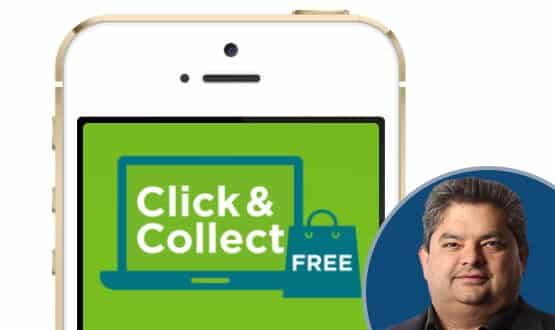Another view: of click and collect

A few years ago, at a partners’ away day, we were brainstorming business development ideas. One of my partners suggested setting up a salmon farm and getting into the fish oil business.
He’s since retired to Scotland. It’s interesting to reflect whether these brain storming sessions say more about the people than the business.
Invent and collect
Another partner essentially suggested what is now called Amazon collect. He was getting lots of packages delivered to our reception, as he was never at home when we had a reception that was open.
(I find it amusing that we thought being open Monday to Friday, 8am to 7pm, was great access. Now we are constantly being told it is not enough).
We wondered if there was money to be made out of performing a similar service for the town. We quickly said ‘no’, of course, as our main mantra is that our activities have to be health related.
Still, Amazon collect happened in other shops. And now, to avoid waiting in shops, there’s another service called Amazon locker.
There is one outside of my local Morrisons. It’s a huge installation, and I assume you go up, type in a code, and the appropriate box opens with your parcel in it. Naturally, you don’t have to get there while the shop is open; or deal with any of its staff.
It all reminds me of the introduction of ATMs. Banks discovered that people would queue up in the rain if there was a shorter wait for an ATM than for a bank teller. It’s about convenience, not human contact.
The 6 o’clock dash
Where am I going with this? Well, the other day I was chairing a meeting in our conference facilities. Our doors shut that evening at 7pm (these days, we do some night opening, but not every night).
I was looking out the window for late comers and I noticed there was a small but steady procession of people driving in, parking up, then running to the front door, finding it closed, and looking around in frustration.
Our head of reception informed me that most of these people are what we call “same dayers”. These are people who contact us saying that they need a prescription or other paperwork urgently – but can’t come in and wait at the desk.
They might want a sick note, a report, a copy of their medication, one of the many forms that we are asked to counter-sign. Most want prescriptions for drugs they claim they have run out of, or lost, or left in their holiday villa.
Some want an urgent prescription for something that they have had before and that we are likely to give without seeing them: creams, eye drops, antihistamines.
All of this is quite disruptive work – remember, it is in addition to seeing all the patients we see and doing all the paperwork we do. And most of the prescription stuff comes up because people say they haven’t remembered to order in time, despite the many ways that can be automated for them.
Even so, we think we go out of our way to help these people (another local practice doesn’t, saying point blank that it’s 48 hours for a prescription).
The limitations of EPS
As a practice, we have encouraged our patients to use electronic transfer of prescriptions. Sending the script direct to the chemist really helps reduce footfall in the surgery.
But the “same dayer” patients often don’t want the script to go ETP; usually because the chemists don’t treat these scripts as a priority and most local chemists have worse hours than we do.
So, our commuter who runs out of medication can’t ask us to send it to their usual chemist because unless he or she can stand and wait with the script the chemist won’t prioritise it.
And by the time our commuter gets home, her usual chemist is probably shut. So our commuter and loads of people like her ask us to leave the script at the desk for them to collect when they get home in an evening.
Then, they end up going to the late chemist in the nearby town. However, many arrive just too late. We could change the chemist nomination to the late one; but there are a couple so we might get the wrong one.
Also, there is no easy way of doing this for one script. So all our commuter’s scripts would go to the late chemist; unless we remembered to turn the nomination back to the normal chemist – which is even more work for us.
It strikes me that what we need is some sort of collect/ATM machine. Load the prescriptions into the machine; tell it who they are for.
Have them turn up and prove who they are. Then dispense the item/paper. Our staff already have a huge box that they file the prescriptions into for people to collect, so loading a machine can’t be that hard.
Surely an ATM manufacturer can produce a machine that stores little slips of paper in it and gives them out on proof of ID?
A better EPS? Or are lockers a go?
However, is that the right solution? Is the right solution to make EPS cope with urgent/same day scripts better?
Yes, if you are on holiday and need to use a different chemist you can change your nomination. But it’s not easy for one tube of hydrocortisone that might have been approved half an hour before you located the chemist in your holiday town.
If my patient is in Manchester and I’m in Sandbach, why can’t I authorise a prescription and have my patient walk into a chemist and call it down?
Why does my commuting patient need to rush home and find a chemist in the evening? Why can’t they sit at their desk in their office, select on a website a nearby chemist, send it a prescription, and add a note saying “I’ll be there in an hour”?
So, we don’t need a locker, we need a better EPS? No, says my head receptionist. Even with EPS, loads of people come into the surgery to collect stuff that isn’t even same day or urgent. Prescriptions yes, but forms and other things.
The queue in reception is half full of people picking stuff up all day. So having an ATM-style machine outside could cut the queue at all hours.
After all, some patients might prefer to use it (even in the rain; perhaps we could provide a canopy). The 24 hour access would just be a bonus.

 |
Dr Neil PaulDr Neil Paul is a full time partner at Sandbach GPs; a large (22,000 patient) practice in semi-rural Cheshire. He is also one of the directors of Howbeck Healthcare Ltd. |
 |



